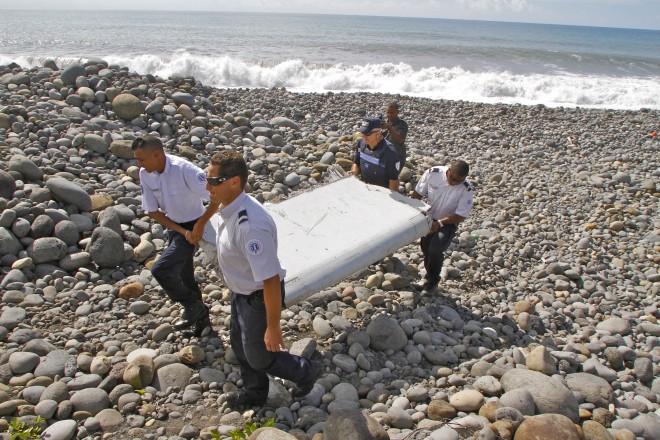
In this photo dated July 29, French police officers carry a piece of debris from a plane in Saint-Andre, Reunion Island. Air safety investigators, one of them a Boeing investigator, have identified the component as a “flaperon” from the trailing edge of a Boeing 777 wing, a US official said. Flight 370, which disappeared March 8, 2014, with 239 people on board, is the only 777 known to be missing. AP
BALMA, France—Representatives of the world’s media gathered Saturday outside a French defense site in Balma, southwestern France, awaiting the arrival of a piece of plane wing that could be from the missing Malaysia Airlines Flight 370.
French authorities have imposed extraordinary secrecy over the 2-meter (6-foot) long piece of wing, putting it under police protection in the hours before it left the island of Reunion en route to the French military site.
Reporters were being kept outside the facility, where French aviation experts will try to establish whether wreckage was part of the Boeing 777 which disappeared March 8, 2014, with 239 people on board.
Wrapped and loaded as cargo, the fragment was being transported to the military aviation laboratory, east of Toulouse.
Air safety investigators, including one from Boeing, have identified the component as a flaperon from the trailing edge of a Boeing 777 wing, a US official said. The official wasn’t authorized to be publicly identified.
Flight 370, which disappeared March 8, 2014, with 239 people on board, is the only missing 777.
Under a microscope and expert eyes, the wing fragment that washed up on the beach of the volcanic island could yield clues not just to its path through the Indian Ocean, but also to what happened to the airplane.
Analysts at the French aviation laboratory hope to glean details from metal stress to see what caused the flap to break off, spot explosive or other chemical traces, and study the sea life that made its home on the wing to pinpoint where it came from.
Even if the piece is confirmed to be the first confirmed wreckage from Flight 370, there’s no guarantee that investigators can find the plane’s vital black box recorders or other debris. A multinational search effort has so far come up empty.